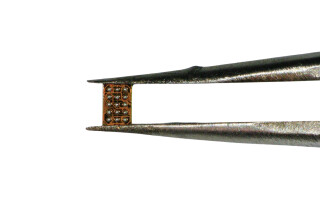Raspberry Pi Pico Capacitive Touch Helper Board – Pico Touch 2
March 01, 2024
Blog

The Raspberry Pi Pico is an incredibly popular dev board, sporting Raspberry Pi’s own RP2040 microcontroller. For all its positives, one thing it lacks is native capacitive touch capability, meaning you need to add high-value (e.g. 1M) resistors to the board to allow for this type of sensing (e.g. my RP20-Footie design). While such resistors are inexpensive, they are also inconvenient to implement, thus I created a capacitive helper board that I’m calling the Pico Touch 2.*
The idea behind this originally came after looking at a mini kalimba finger piano and wondering if it could be made into a MIDI device. While an Arduino Pro Micro could probably have done the job, the popularity of the Pico and the ability to use CircuitPython were factors that led me to instead use the Pico in this instance. The end result, shown in the video below, is that I was able to make two versions of the MIDI kalimba, the first using soldered-on THT resistors, and the larger one using SMD components via my new helper board.
So that is what I have done with it so far, but what about the board itself?
The Pico Touch 2 Board
The current version of this board features an array of 16 resistors through which GPIO 0-15 on the Pico connect to ground. The Pico can be soldered on, or (in theory) connected via headers, although I have yet to test the header implementation. 16 IO gives it ample capacitive overhead for many projects, and to potentially save space, I made a long cavity down the center with rat bites on the sides, which allow the non-capacitive section to snap off if needed.
The non-capacitive section simply passes IO to the edge to allow for easier alignment. Pin labels are only on the left side per its constricted layout, and it’s constructed out of .8mm FR4–a rather compact arrangement in all three dimensions.
It’s a functional board, but like most any project it could still use a bit of refinement. Read on to avoid making the same mistakes that I did:
Mistakes and Potential Improvements (Smaller Than Needed?)
.jpg)
Caption: Rat bites and middle cavity worked, but were largely unneeded / Image Credit: Jeremy Cook
Because it was originally envisioned as being able to fit inside a mini kalimba, I focused on making it very small. The right side was designed as a non-capacitive pass-thru only, saving roughly 2.5mm off the width of the board, while a rat-bite/cavity arrangement meant the right side could be done away with altogether if needed.
Both space saving concepts worked, however, neither seemed worth the hassle. When intact, the board is still too large to fit entirely on a small breadboard, and snapping off one side would make it horizontally asymmetrical. Snapping the board isn’t exactly clean either, and I think it’s a feature that few would actually use. PCBWay, which made this board, and possibly other board houses, charge more for snap-away construction making its cost/value proposition even lower.
Finally, its asymmetrical design means that a significant number of GPIO pins don’t have the option for capacitive touch, nor do they have supplemental pin labels applied to one side. Sure, 16 GPIO seems like it should be enough, but my big kalimba just so happens to have 17 keys. Off by one cap touch input!
On the positive side, the 0603 resistors were a good choice size-wise, even though they were difficult to solder. I didn’t order a stencil which was a mistake, so don’t forget to get one if needed. Better yet, have your PCB house handle assembly made for you. It may seem expensive, but don’t forget to consider the value of your time (and mental health).
New Improved Pico Touch 2 R1!
.png)
Caption: No more rat bites, extra resistors, labels, and connections / Image Credit: Jeremy Cook
With these thoughts in mind, I’ve ordered a rev. 1 version of the Pico Touch 2 and listed it for sale on Tindie. This device features not 16, but 23 1M resistors for even more cap touch goodness. It also has extra connections for most of the other pins and labels on both sides. I hope people will be able to make their own awesome projects with it, and if you’re wondering about bringing your microcontroller product to market, do check out my Developing With Arduino Class Series. It’s focused on professional and commercial applications–and leveling-up your maker project to a sellable “thing”–and will be running throughout 2024.
*One might ask: why “Pico Touch 2,” not just “Pico Touch?” Here I’m trying to set it apart from other things that might be described as Pico Touch, and like my EZ Fan 2 and JC Pro Macro 2, releasing a sequel seems to be my (rather unintentional) calling card.




